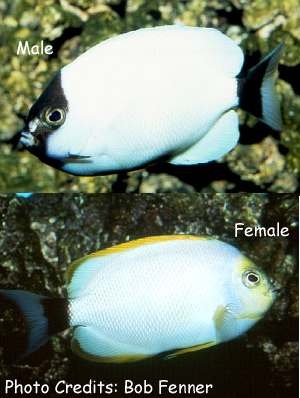
By Bob Goemans

Likely Reef Tank Suitable
Likely Fish-Only Tank Suitable
Range: Central Pacific Ocean: Endemic to the Hawaiian Islands.
Size: 8 inches (22 cm)
Natural Environment: Inhabits rocky fore-reef slopes and often collected at depths between 60 to 400 feet (20 - 120 m) and is generally a plankton feeder, yet stomach contents has shown it also feeds on macroalgae, detritus, and crustaceans.
General Husbandry: This species is rarely collected and seldom ever seen in the trade. Yet when available, makes for a colorful and peaceful addition to both fish-only and reef aquariums. Yet note this species comes from waters that are slightly cooler than what most hobbyists maintain their aquariums, i.e., high 70’s to low 80’s. Therefore, consider somewhat lower aquarium temperatures, possibly low to mid 70’s if wanting to maintain a wild caught specimen.
Females are pearly white overall, with a black mask on the head, and a black band on the anterior portion of the tail, and also have yellow pelvic fins. The body of the male is also a pearly white, yet has a yellow face, and its dorsal, anal, and pelvic fins are yellow. It also has a black band on the anterior portion of the tail. Both have a tail that tapers into the body, resulting in what can be called a swallowtail appearance. In fact, those in this genus are sometimes called Swallowtail Angelfish.
Best maintained in moderately lit aquariums since they are usually collected in somewhat deep water. As to diet, they should be offered at a minimum several daily feedings so as to quickly acclimate it to its surroundings. Like many others in this genus, their captive diet should consist of a wide variety of meaty foods including fortified brine shrimp, mysis and angelfish food preparations, and continued to be offered several times daily after its acclimated to its surroundings. Some flake foods, especially those containing Spirulina should also be offered, as algae, especially Spirulina is a healthy addition to all that consume it.
Depending upon its tankmates, it can be quite shy when first entering the aquarium, and may hide in caves and crevices. But as time passes, will become more outgoing. Those in this genus, as those in the genus Apolemichthys and Chaetodontoplus, are almost always very good tankmates and considered one of the least aggressive in the family. Keep in mind males will fight among themselves, so the limit is one per aquarium, whereas multiple females can be maintained, and all can be maintained with other genus angelfish.
Taxonomy:
Order: Perciformes
Suborder: Percoidei
Family: Pomacanthidae
Genus: Genicanthus
FYI: Keeping more than one genus of angelfishes in the same aquarium is possible, yet depends upon several aspects. The following suggested circumstances are just that, possibilities that when heeded and adjusted to actual aquarium conditions ‘may’ make multiple angelfish collections feasible.
Aquarium size – the larger the better.
Other species from the same genus should not be in the same aquarium.
The smallest and most docile genus species should be the first introduced with the largest and most malicious the last to be added.
Do not place similar coloration species in the same aquarium.
Those already in the aquarium should be well fed before adding a newcomer.
Have sufficient hiding places/rocky caves.
Keep in mind all angels have cheekspines at the edge of their gill cover; therefore use caution when handling and also avoid using a net to capture it, as it may become stuck or tangled in the net and become damaged when removed.
Has been captive bred in 2014 – search the Internet for more information.
Experience Level: Intermediate
Temperament: Peaceful
Diet: Planktivore
Acclimation Time: 30 minutes+
Aquarium Environment: Fish-only and reef aquariums
Reef Safe: Yes
Minimum Tank Size: 150 gallons
Temperature Range: 70 - 75°F (21 – 24°C)
Specific Gravity: 1.020 - 1.026
pH: 8.0 - 8.5
